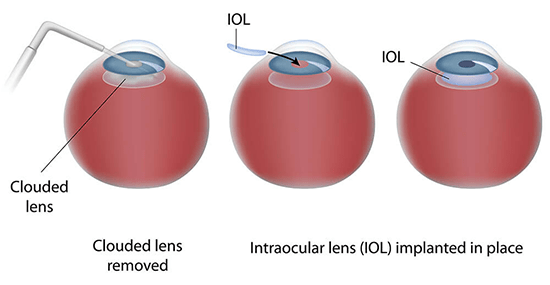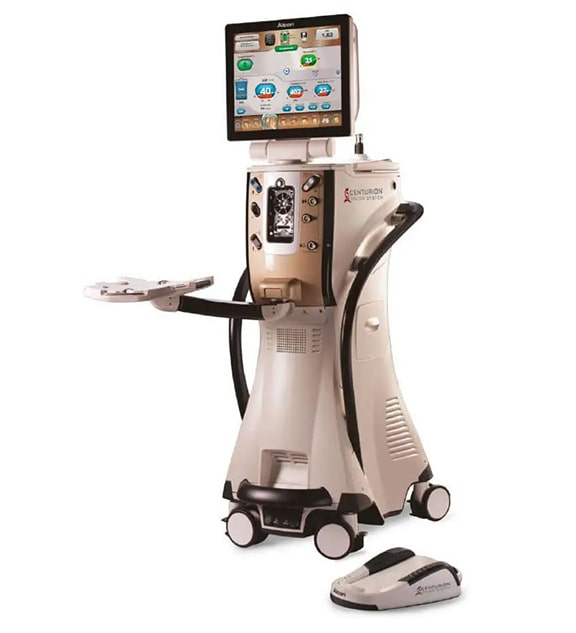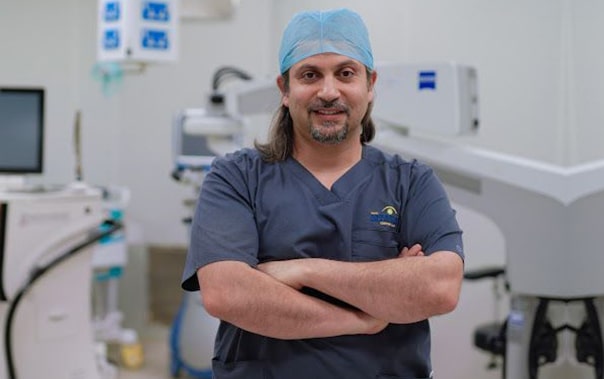Improve blurred vision caused by cloudy areas on the lens of the eye. It is time to see the world clearly with this safe procedure.
Modern & Safe Laser Cataract Surgery
An experienced ophthalmologist surgeon performs the procedure using ultrasound waves which makes the operation fast and safe and requires a simple day surgery.
No injections or general anaesthesia is required. The complete surgery is done with topical anaesthesia (numbing eye drops).
Through the use of Centurion phacoemulsification, this superior cataract surgery machine breaks up the cataract through microscopic keyhole surgery. No stitches are required after the surgery.
See the world in perfect vision! Our day surgery is performed for any age, from young to old, and you will immediately notice an improvement in your eyesight.
There is a good reason why the North American LASIK & Eye Surgery Centre is the gold standard for cataract surgery. We use devices which include laser and ultrasonic technology for cataract surgery. The surgeon will replace the defective lens and replace it with an intraocular lens, otherwise known as an IOL.
Types of Intraocular Lenses
The intraocular lens (IOL) is the implant that replaces your eye’s natural lens. IOLs are used in both cataract surgery and refractive lens exchanges. IOLs are usually smaller than a dime and made of clear plastic. To maintain the lens in place inside the capsular bag, IOLs typically have plastic side struts, called haptics.
Schedule a free consultation with our doctor to guide you on the appropriate treatment options available.
After surgery, these lenses can improve distance vision, but near-vision activities, such as reading a book or label, may require glasses. Lenses like this provide good distance vision, especially in dim lighting conditions.
EDoF IOLs eliminate some of the side effects associated with multifocal IOLs. During the night, they minimize the halo effect while providing excellent visual quality. They are best for people with astigmatism, cataracts and presbyopia
PanOptix® Trifocal IOLs are multifocal IOL devices designed to focus images onto the retina after cataract removal to allow clear vision. It provides better near and intermediate vision compared with what a monofocal lens would provide. It’s the best choice for avid readers and office workers.

Cataract Technology Procedure
North America Laser Clinic has done over 4000 cataract surgeries with excellent success. Our team includes surgeons, specialized ophthalmic technicians and nurses committed to providing excellent eye care. Take a look at our testimonies on Facebook.

Step 1: Getting Rid of Cataracts
The surgeon will insert a pen-tip-sized instrument into your eye to remove the cataract by either breaking it up with high-frequency soundwaves (phacoemulsification) or washing it away with fluid pulses (a process called liquefaction).
Step 2: Adding the lens
Artificial intraocular lenses are used to replace lenses containing cataracts (IOLs). The surgeon inserts the artificial lens through a small incision made in the cornea with an IOL made from a flexible material. To keep the IOL in place, it’s haptics (or “arms”) unfold once it is inserted.
Step 3: Restoring Vision
Once the cataract has been removed, and the IOL is in the correct position, the light can travel unimpeded to the back of your eye. Cataract surgery usually results in a quick recovery within a few days.
What you need to know about cataract treatment.

Centurion Vision System
The North American LASIK and Eye Surgery Center is proud to be using the Centurion Vision System. Using ultrasound energy, it breaks up and removes cataracts with phacoemulsification.
This system allows the eye surgeons to remove cataracts more effectively than ever before. Unlike other phacoemulsification technologies, it optimizes every step of the cataract removal procedure.
The Centurion Vision System adapts automatically to changes in the condition of the eye to provide safe cataract removal and superb vision quality.
At the North American LASIK and Eye Surgery Centre, we perform weekly eye surgeries and have done over 4000 cataract surgeries since we first opened our clinic in 2013.
The founder is a Graduate of the Royal College of surgeons, McGill University and university of Toronto and holds the Canadian board of Ophthalmology. The clinic is internationally accredited by the Emirates International Accreditation Centre to perform Cataract surgeries.
Our team of surgeons, technicians and nurses are constantly updating their skills and knowledge through on site training and seminars.
We have done over 16,000 eye surgeries at our clinic and we see clients from over 47 countries.

Frequently Asked Questions
Patients over 55 are more likely to develop cataracts, but anyone is susceptible to developing one. Most people over 65 have developed cataracts, and most people over 75 have at least one. They are caused by natural aging.
- Cloudy, foggy, blurry, or filmy vision.
- Driving can be difficult due to light sensitivity, glare, and halos at night.
- Fading or yellowing of colors.
- A constant need to change glasses or contact lenses with a slight improvement in vision.
- The affected eye has double vision.
A cataract can sometimes be managed in its early stages. By changing your glasses prescription, you may be able to improve your vision and prolong the time before you have to have cataract surgery. However, dysfunctional lens syndrome often develops at this stage.
Cataracts impair vision and can only be restored by surgery. Despite ongoing research, surgery remains the only treatment available. Modern cataract surgery has made tremendous progress, making it highly effective in treating all aspects of the disease.
● Clarity and crispness of vision
● An effective and safe method
● Stitches or injections are not required
● Noticeable brightening and vividness to the colors
● Few days to recover and is relatively painless
● Positively affects self-esteem and quality of life
● Surgery can also correct other ocular disorders (e.g., presbyopia, astigmatism, myopia/nearsightedness, hyperopia/farsightedness).
To prevent pain during cataract surgery, your surgeon will use a local anaesthetic (numbing eye drops). It is possible to use additional medication depending on the patient and the type of procedure.
Your eye may feel scratchy the first day after the cataract surgery. You can relieve discomfort with a variety of over-the-counter pain relievers. The surgeon may prescribe more vital pain medication if necessary.
An anaesthetic is administered before surgery to minimize the pain during the procedure. In most cases, the surgery will only take 10-15 minutes per eye. The cataract is broken up into tiny pieces and removed through a hole in the capsule bag. Ultra-precise keyhole surgery is then performed to implant the new intraocular lens.
You can relax in our relaxation suite for 30-45 minutes after surgery.
A consultation with your surgeon will begin the cataract treatment process. During this meeting, your consultant will perform special eye diagnostics and discuss lens options.
Upon arrival at the clinic, you’ll be given eye drops to dilate your pupil before surgery. You will then be guided by a nurse on how to look after your eye following surgery so that you are comfortable with it.
You’ll have your eyes checked a final time before you go home. You’ll also be given some eye drops and instructions about how often to use them and how long.
There will be a gritty feeling in your eyes for the remainder of the day, so do stay at home and rest. Your vision will be slightly misty for up to 72 hours after surgery, but you may immediately notice a dramatic improvement in your sight.
In cataract surgery, one eye is typically operated on at a time to evaluate the outcome before moving on to the other. A second surgical procedure may be impacted by this evaluation, primarily when a trifocal intraocular lens (IOL) is used.
The lens where the cataract develops has been removed and replaced, so there is no possibility of the cataract growing back. An intraocular lens (IOL) implant does not require maintenance or replacement.
After cataract surgery, a cloudy film may form behind the implant on the lens capsule membrane, usually a few months after the surgery. It is referred to as posterior capsular opacification or secondary cataract (the cataract appears to have returned).
A “secondary cataract” has similar symptoms to an original cataract, but it is treated using a simple laser outpatient procedure called YAG laser capsulotomy. Using a specialized laser, the surgeon can create an opening in the capsule to restore vision safely and quickly. It is a quick, painless, and most of the time, a permanent procedure that takes only a few minutes.
